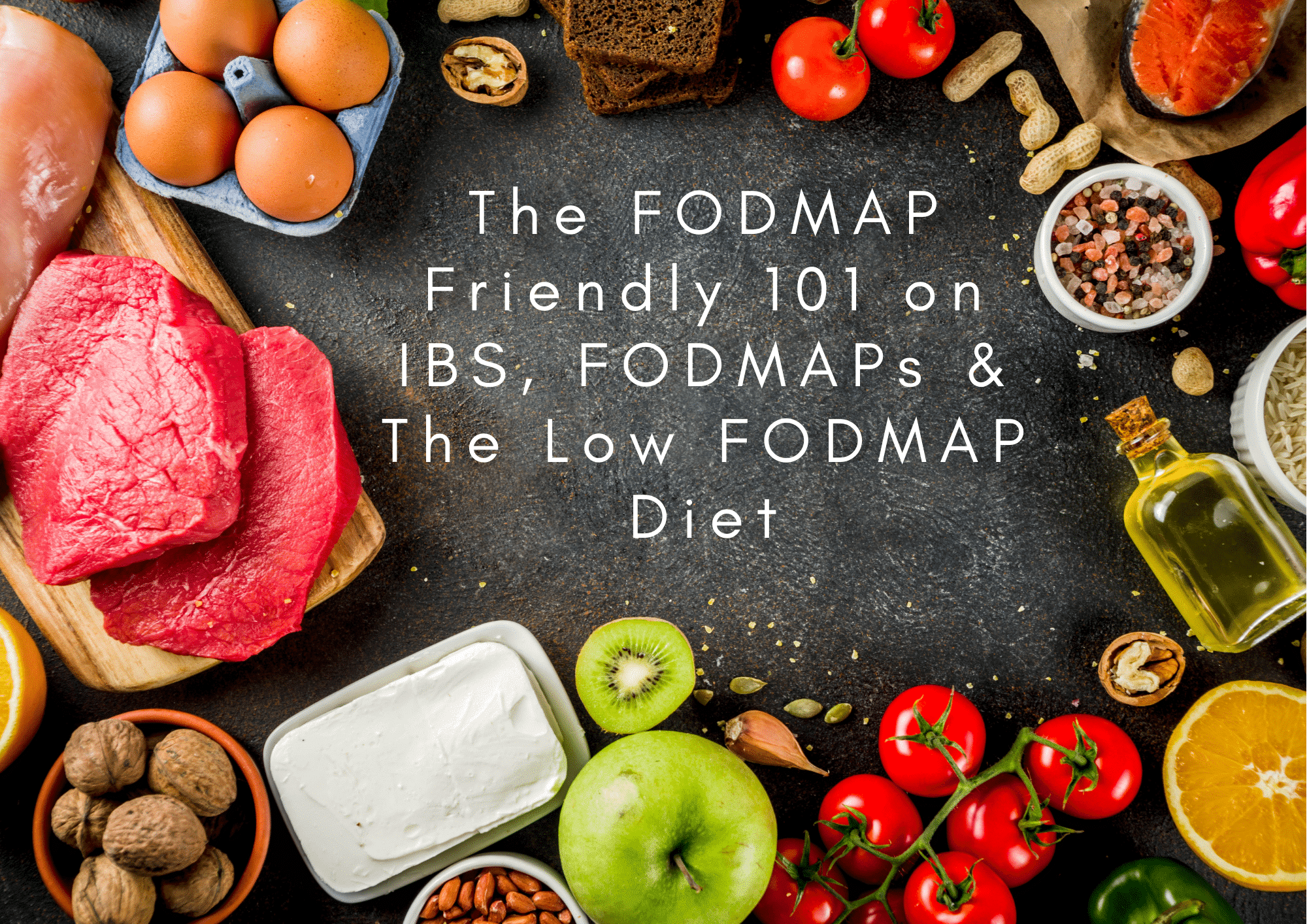The FODMAP Friendly 101 on IBS, FODMAPs & The Low FODMAP Diet
Posted on September 16, 2020

Here at FODMAP Friendly, we love our acronyms! However, what we love even more is assisting people with IBS symptoms to shop and eat with confidence. Education is a key piece of the puzzle when achieving this mission. Today on the blog, we are giving you the 101 breakdowns on IBS, FODMAPs, The Low FODMAP Diet and how FODMAP Friendly slots into these concepts.
IBS – what is it, how many people have it & how do I know if I have it?
Irritable Bowel Syndrome (IBS) is a condition that affects the functioning of the bowel. People with IBS tend to have bowels that are more easily ‘upset’ than those without IBS. What does an ‘upset’ bowel look like? Think abdominal pain, bloating and alternating diarrhoea & constipation associated with eating. It is important to note that IBS is a functional disorder – it doesn’t cause lasting damage nor contribute to the development of serious bowel conditions, such as cancer or colitis. However, there is no denying that the pain caused by IBS is very real, even if the bowel appears normal in scans.

IBS is the most common gastrointestinal disorder worldwide – 1 in 7 people, or 15% of the population experience IBS. This means it is highly likely that someone you know has already been diagnosed with this condition. Women tend to be more prone to IBS than men, and symptoms usually occur first in early adulthood.
The cause of IBS is unknown, but environmental conditions such as high stress, change of routine, infection and diet may cause flare ups. People with IBS tend to present with a collection of unpredictable and often embarrassing symptoms which may significantly impact their quality of life. These symptoms include:
- Diarrhoea – sometimes referred to as IBS-D
- Constipation – sometimes referred to as IBS-C
- Excessive wind
- Bloating/distension
- Cramps
- Fatigue

The symptoms of IBS are not ‘unique’ – they align identically to other gut conditions which can make a diagnosis of IBS difficult. If you suspect that you may have IBS, it is important to first seek medical advice to ensure that your symptoms aren’t caused by any other serious gut conditions such as Inflammatory Bowel Disease (IBD), coeliac disease or even bowel cancer. A doctor may complete a full medical check-up, blood tests, including blood tests to screen for coeliac disease, stool tests, and if further testing is needed, an investigation of the bowel lining by inserting a small tube (sigmoidoscopy) or of the large bowel via a colonoscopy.
FODMAPs – the sneaky cousin of IBS
FODMAPs are types of sugars (short-chain carbohydrates) that can trigger the uncomfortable digestive systems of IBS. You may like to think of FODMAPs as the sneaky cousin of IBS that hide in a wide range of foods and drinks such as milk, garlic, onion, beans and wheat. FODMAPs are known to be poorly absorbed in the small intestine, where most nutrients are absorbed and instead ‘overstay their welcome’ by continuing to the large intestine (colon). This is where FODMAPs thrive as they are fermented by gut bacteria and can trigger symptoms such as bloating, excess gas and cramping in people with a more sensitive gut, such as those with IBS.
The term FODMAP is an acronym that stands for:
Fermentable – meaning the carbohydrates are broken down (fermented) by bacteria in the large bowel
Oligosaccharides – “oligo” means “few” and “saccharide” means sugar. These molecules made up of individual sugars joined together in a chain e.g. fructans and galactooligosaccharides (GOS).
Examples of ‘O’ foods: wheat, rye, barley, onions, leek, garlic, legumes, lentils
Disaccharides – “di” means two. This is a double sugar molecule e.g. lactose
Examples of ‘D’ foods: milk, evaporated milk, yoghurt, ice-cream
Monosaccharides – “mono” means single. This is a single-sugar molecule e.g. fructose
Examples of ‘M’ foods: honey, mango, apples, pears, watermelon
And
Polyols – these are sugar alcohols (however don’t lead to intoxication!) e.g. sorbitol & mannitol
Examples of ‘P’ foods: apples, apricots, nectarines, cauliflower, products (e.g. gums and confectionery, particularly ‘sugar free’ foods) sweetened with polyols

How do FODMAPs trigger symptoms?
FODMAPs have two common traits that influence how they trigger digestive symptoms:
1. They attract water into the intestine. This can great pressure in the gut and result in fully or partially loose stools (diarrhoea).
2. They are rapidly fermented in the large intestine by gut bacteria, which results in release of gas which can cause the intestinal wall to stretch and expand. In people with a sensitive gut (i.e. people with IBS), the stretching and can trigger digestive symptoms including bloating, cramping, abdominal pain and constipation.

What does the low FODMAP diet involve?
A diet low in FODMAPs (the ‘low FODMAP diet’) has been scientifically proven for the management of the uncomfortable digestive systems associated with IBS. The protocol is evidenced to help up to 80% of people with IBS manage their symptoms by reducing osmotic load and gas production in the distal small intestine and large bowel. The goal of a low FODMAP diet is not to cure IBS, but to identify which FODMAP groups are involved in triggering or exacerbating IBS symptoms and use this information to develop a personalised eating plan that ensures as much variety and as little symptoms as possible.
Remember, the diet is a diagnostic tool, not a forever diet! In fact, many FODMAPs are prebiotics and have a positive effect on our gut health and should not be eliminated unnecessarily in the long term. The Low FODMAP diet commonly involves three-phases: elimination, reintroduction/challenging FODMAPs and maintenance/individualisation.
Elimination is the trial phase of the low FODMAP diet that removes all FODMAP groups, even if you think they are well tolerated. The purpose of this phase is to determine whether removing FODMAPs makes a significant difference to symptoms. This step usually lasts around two to four weeks.
The reintroduction/challenge phase is commenced if symptoms have improved significantly upon completion of the elimination phase. The challenge phase aims to identify which FODMAP groups are well tolerated and which ones are problematic. This reduces the need for an over-restrictive elimination-style diet, which can limit foods high in prebiotics and plant variety. The challenge phase is structured and systematic – similar to running an experiment.
Finally, the individualisation/personalisation phase includes well tolerated high FODMAP foods in the diet. It aims to give IBS patients the knowledge of which foods may give them symptoms but allows them to work to balance symptoms with food desires. Generally, most people don’t react to all FODMAPs, but rather have one or two main FODMAP triggers. This means that the long-term personalisation phase of the diet provides much more variety than the initial elimination phase.
A FODMAP-specialised dietitian is a great person to have on your IBS management team. A dietitian can perform a full patient assessment, including a symptom assessment and diet. They will be able to answer all of your FODMAP questions, and help you choose the best course of action when it comes to the way in which you’d like to implement the diet. Also, there is greater risk of nutritional inadequacy when eating low FODMAP which could lead to nutritional deficiencies in the long term. Dietitians will help ensure that you are meeting all of the nutritional requirements when eating low FODMAP.
When you try to embark on the low FODMAP diet yourself, it can be very easy to make mistakes and feel discouraged. A dietitian will equip you with the knowledge and tools you need to succeed through the three phases.

How does FODMAP Friendly slot in?
As mentioned earlier, the FODMAP Friendly mission is to assist people with IBS symptoms to shop and eat with confidence. We help do this through our FODMAP Friendly accreditation- the only registered certification trademark worldwide certifying FODMAP levels in food products that have been laboratory tested to be low in FODMAPs.
Levels of FODMAPs in food vary depending on the portion size and the way the food is processed. Therefore, it can often be tricky to read food labels to work out if a food is low FODMAP. Many food companies are now registering their products for FODMAP Friendly accreditation. If you see the green FODMAP Friendly logo on any food products, you have the ‘green light’ and can rest assured that product is suitable for consumption while following a low FODMAP diet at the packet serve size. You can browse the extensive range of certified FODMAP Friendly products here and be sure to look out for our logo next time you’re at the supermarket.
Our mission spans beyond certifying products. We also offer the FODMAP Friendly app where you can search for specific foods and discern their FODMAP content & recommended serve sizes. We also have a database on the app of FODMAP-specialised dietitians near your location. Beyond the app, our blog also offers reputable, educational information on all things IBS, FODMAP & gut health as well as recipes using certified products.
There we have it – your 101 on IBS, FODMAPs, the low FODMAP diet and how we at FODMAP Friendly slot in. You can find out more by following us on Facebook and Instagram too.
Written by: Charlotte Barber (Student Nutritionist)
Reviewed by: Sotiria Karatsas (Dietitian)








